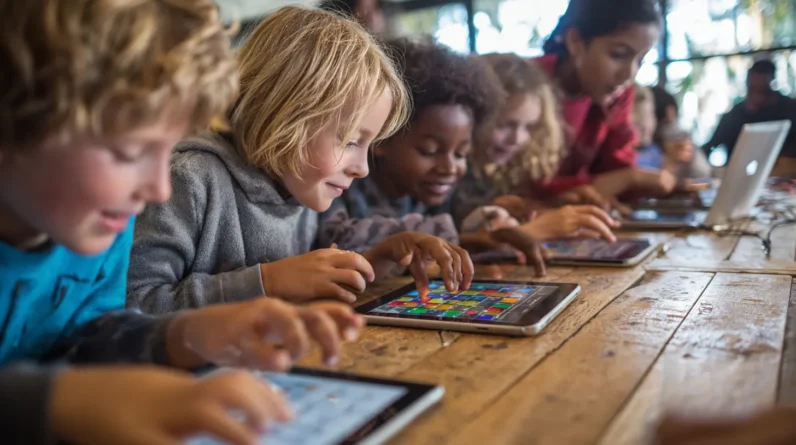
We’re spending about 44 years of our lives staring at screens, which substantially impacts our health and well-being. Tech addiction is linked to depression, anxiety, and sleep issues. It’s vital we recognize the signs and set goals to reduce our screen time. As we explore this topic, you’ll discover how tech shapes us and what we can do to maintain a healthy balance.
Technology Addiction Prevalence and Usage Patterns
We’re witnessing a concerning trend in technology addiction, with a significant portion of the population at risk. We see that 73% of teens and 71% of young adults are at risk for internet addiction. American adults will spend about 44 years of their life looking at screens. Smartphone dependency is high, with 75% of Gen Z saying they spend too much time on their phones. Globally, an estimated 210 million people suffer from social media and internet addiction. We’re actively using our devices everywhere, from bed to social meals, indicating a blurred line between tech use and daily life.
Mental Health Consequences of Tech Addiction
The mental health consequences of tech addiction are alarming, and it’s essential that we recognize the risks. We’re seeing a significant link between tech addiction and depression, anxiety, and even suicidal thoughts. Our reliance on technology is affecting our sleep, cognitive function, and emotional well-being. We’re experiencing tech fatigue, feeling mentally drained, and struggling with social isolation. It’s imperative that we are aware of these consequences and take action to mitigate them. By acknowledging the risks, we can work towards a healthier balance between technology use and mental well-being. We must take this issue seriously.
Physical Health Impacts From Excessive Device Use
Recognizing the mental health consequences of tech addiction is just the first step – it’s also important to weigh how excessive device use affects our physical health. We’re seeing eye strain, musculoskeletal issues, and sleep disturbances.
| Health Issues | Effects |
|---|---|
| Eye Strain | Headaches, blurred vision |
| Musculoskeletal | Neck, shoulder pain |
| Sleep Disturbances | Poor sleep quality |
| Physical Fitness | Obesity, metabolic disorders |
We must consider these risks to mitigate the physical health impacts of excessive device use.
Social and Behavioral Effects in Youth
As we explore into the social and behavioral effects of excessive device use on youth, it’s clear that the consequences extend far beyond the individual’s physical health. We’re seeing significant impacts on their mental and social development. Some key effects include:
- Increased risk of addiction-like symptoms
- Negative impacts on attention span and behavior
- Higher risk of depression and anxiety
- Social isolation despite constant connectivity. We must consider these effects to understand the full scope of excessive device use on youth.
Quality vs. Quantity of Screen Time
When we consider the impact of screen time on youth, we’re finding that it’s not just about how much time they spend on devices, but what they’re doing with that time that really matters. We’re learning that quality screen time, which emphasizes educational or interactive use, is more important than just limiting hours spent on devices. A balanced approach supports children’s ability to navigate digital environments with skill and autonomy. Guidance toward curated activities helps develop healthier habits. By prioritizing quality over quantity, we can promote learning, mental health, and cognitive development in children, while minimizing potential negative effects.
Recognizing Signs of Addiction
We’re apt to overlook the fine line between a child’s enthusiasm for digital devices and a burgeoning addiction, but it’s essential that we don’t. Recognizing signs of addiction is pivotal. We notice when kids
- exhibit excessive preoccupation with digital devices
- experience withdrawal symptoms like irritability
- neglect face-to-face social interactions
- show decline in academic performance. We must be aware of these signs to address potential issues early on.
Recommendations and Awareness
To address the growing concern of technology addiction, it’s essential that we develop effective strategies for prevention and intervention. We recommend setting specific goals for reduced technology use and creating “smartphone-free zones” in the home. Educating users on healthy use versus compulsive habits is also pivotal. We encourage regular self-monitoring to recognize problematic use early. By promoting awareness of mental health risks and highlighting the importance of offline interactions, we can foster responsible technology use. We can also use therapeutic interventions like CBT and support resources to aid in recovery, ensuring a balanced approach to technology use.
Conclusion
We’re caught in a Faustian bargain, trading our well-being for the allure of endless screens, echoing the timeless warning that “absolute power corrupts absolutely.” As we navigate this digital landscape, it’s vital we recognize the fine line between smart kids and addicted minds, lest we sacrifice our youth’s potential on the altar of technology.







